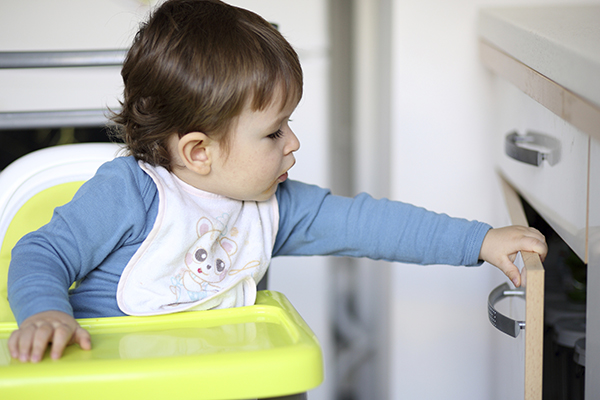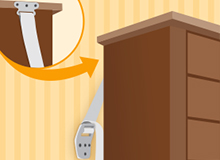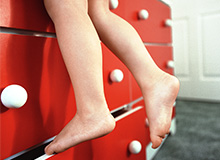
Parents want to protect their children from harm. Childproofing your home is essential to keeping them safe. Unfortunately, even the most caring parents can believe childproofing MYTHS. They may read inaccurate information or hear outdated advice. Read on to make sure you have not fallen for any of these common MYTHS, and if you have, our experts share some great safety tips to help you.
Myth #1: “My house and furniture are safe.”
Many items in the home can pose risks, but parents may not be aware of which can cause an injury to a child or underestimate how quickly young explorers find trouble. Many hazards that could cause a serious injury to a young child are commonly overlooked. Take furniture, for instance. People sometimes assume that because they bought a heavy dresser from a well-known store, it will not tip over. Furniture can tip-over because it is lightweight, easy to pull down, or poorly made. However, furniture can also tip over because a small person hanging onto it or opening the drawers changes the center of gravity, making a tip over likely. It is important to anchor furniture throughout your home to prevent tip-over injuries.
Tom Treanor, owner of All-Star Baby Safety in Melville, New York, notes that parents often think screens will prevent their children from tumbling out of a window. “They forget that screens are there to keep insects out, not to keep children in,” he says. “The idea that screens keep kids safe is a big misconception.”
Yehudah Franken, owner of Babyproofers Limited in Toronto, shows parents the dangers of the spindles in their home’s railings. “Some parents believe that since their baby’s head can’t fit between the rails, they are all set,” he explains. “I have to show them that the child can fit his body through feet first, resulting in a strangulation hazard. The building code for railings allows for a wider spacing than crib and baby gate spindles, but parents don’t know that can be dangerous.”
Flat screen television sets are very large (and larger models are becoming available and more affordable). Ones that have a small stand are inherently unstable and not designed to be pulled on by a child. TVs should be attached to the back of anchored furniture or the wall behind them.
Myth #2: “Childproofing my home will take a lot of time and effort and will make daily tasks more time-consuming.”
Properly childproofing your home does take time. Working in stages as your child grows, however, reduces how much time needs to be spent all at once. Some parents also fear that the installed latches and locks will make the adult’s daily life more difficult. In reality, quality products are very easy to use and usually don’t take more than a fraction of a second to operate. Without these products, it is exhausting and time-consuming, for example, to constantly redirect your child as he/she keeps trying to open a cabinet or enter a room that is not safe. Having latches and locks often makes a parent’s life much easier and saves time in the long run. Parents can actually relax a little and have peace of mind when they watch their child explore their babyproofed home.
Myth #3: “I bought a childproofing product and installed it correctly, so my child is safe.”
Sadly, there is almost no government oversight on what can be labeled as a childproofing product, and whether such items work as promised. The marketplace is full of safety products that are poorly designed and might not work as advertised in situations commonly found in many homes.
Many products are also unnecessarily difficult to operate. For example, if a parent installs a gate that cannot be unlatched easily, he/she may end up leaving the gate open or climbing over it. In this case, the product is ineffective and even creates an additional tripping hazard when the parent attempts to climb.
Many products are difficult or tricky to install and come with confusing or complicated instructions, leading to incorrect installation. In Treanor’s experience, one of the most challenging products is magnetic cabinet locks. “Installing these locks correctly requires positioning them very accurately—to within 1/16 of an inch,” he explains. “That’s a level of accuracy an average person can’t realistically achieve.” On a recent home visit, Treanor was able to open 15 magnetically-locked cabinets without using the magnetic key within a few seconds, to the horror of the watching parents. “Those locks were giving the parents a false sense of security,” he notes, “which can be more dangerous than having nothing installed.” Franken has seen parents who struggled to install baby gates without having the adaptive framing or hardware needed to deal with baseboards. “They end up mounting gates too high that the child could easily get through or become trapped beneath them,” says Franken. “Proper framing can fix this problem, but the average homeowner doesn’t know how and the instructions don’t show how either.”
Myth #4: “My child is never unattended.”
First-time parents often believe their baby will always be under their watchful eyes. They likely cannot imagine how fast their toddler will be able to move. Also, it is not possible to watch a child 100% of the time. In the course of a day, parents do many tasks that momentarily distract them, preventing them from giving full attention to a young one: preparing a meal, answering the phone or doorbell or getting something from another part of the house. Everyone needs to sleep, shower, and use the bathroom. Many injuries happen when a parent is momentarily distracted and nearby, watching baby get hurt even though they might only be a few feet away. Parents also forget that grandparents or sitters will someday watch the child, and they may be less likely to hover over the child’s every move. Childproofing products are the backups when normal life happens.
Myth #5: “I will teach my child no.”
The myth that young children can be taught to consistently obey is widespread. Popular books assert that babies and toddlers can be taught “no” and will always listen, but any experienced caregiver knows this is unrealistic. Despite good intentions, your child will not consistently obey your “no” for a long time. This does not reflect badly on your parenting or on your child’s impulse control. It is the simple reality of human brain development. As babies grow, their willpower develops and they may one day decide to disobey a rule they have consistently followed. This is especially likely as they approach the age of two. The latest research on children’s brains shows that it takes years for kids to learn how to control their impulses. Everything that a young child learns takes lots of repetition—getting dressed, brushing teeth, washing hands. Not touching something that looks fun to touch is another skill to be perfected over time. In the meantime, it is essential to have your home childproofed.




